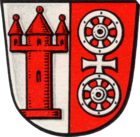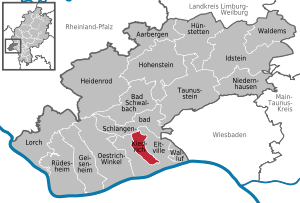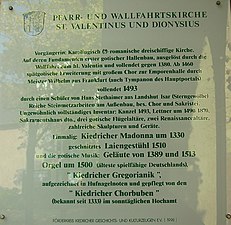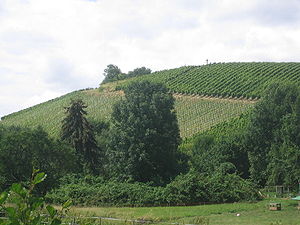Kiedrich
| coat of arms | Germany map | |
|---|---|---|

|
Coordinates: 50 ° 2 ′ N , 8 ° 5 ′ E |
|
| Basic data | ||
| State : | Hesse | |
| Administrative region : | Darmstadt | |
| County : | Rheingau-Taunus district | |
| Height : | 165 m above sea level NHN | |
| Area : | 12.35 km 2 | |
| Residents: | 4087 (Dec. 31, 2019) | |
| Population density : | 331 inhabitants per km 2 | |
| Postal code : | 65399 | |
| Area code : | 06123 | |
| License plate : | RÜD, SWA | |
| Community key : | 06 4 39 009 | |
| Address of the municipal administration: |
Marktstrasse 27 65399 Kiedrich |
|
| Website : | ||
| Mayor : | Winfried Steinmacher ( SPD ) | |
| Location of the municipality of Kiedrich in the Rheingau-Taunus district | ||
Kiedrich is a wine-growing community in the Rheingau-Taunus district in southern Hesse .
geography
location
Kiedrich is located in the Rheingau on the southern slope of the Taunus , about two kilometers north of the city of Eltville am Rhein and three kilometers from the banks of the Rhine . Kiedrich only includes the district of the same name (Gmk.-Nr. 60647).
It begins in the south just behind the Marienhöhe children's village , which lies above Erbach in the vineyards and includes the monastery mill on the outskirts of Eltville. From here the municipality extends as a strip of one and a half and two kilometers wide about 7 kilometers to the north over the Taunushauptkamm to the outskirts of Hausen vor der Höhe . Up here, Kiedrich's highest elevation is the Dreibornsköpfe at 548 meters . The lowest point at the Klostermühle is about 105 meters. Almost the entire area is drained by the Kiedricher Bach and its tributaries, the Grünbach , the Pfaffenborn and the Sillgraben , which have carved a distinctive valley system into the southern roof of the Taunus.
Very rich drinking water wells were developed in the municipality, so that Kiedrich is the only Rheingau commune that can supply itself with drinking water in sufficient quantities at all times and even supplies the neighboring town of Eltville.
The center of Kiedrich lies at an altitude of 165 meters and the location has spread 1,500 meters west of the Kiedricher Bach on the north-east exposed, sunny slope. The sun-drenched south and south-west slopes of the district are predominantly vineyards up to a height of about 250 meters. To the north of it, the Kiedricher community forest joins in the higher elevations.
Outside the locality, there are a number of buildings on the Kiedricher Bach, from the forest mill to the monastery mill . And visible from afar, the keep of the Scharfenstein ruin rises north of Kiedrich on a mountain spur above the valley on the border between forest and vines . On the other hand, the remains of the Dreibornskopf ring wall near the Taunus crossing to Hausen vor der Höhe are barely noticeable in the forest . All the more striking, on the other hand, are the 300-meter-high modern buildings built after the war on Hahnwald northwest of Kiedrich.
Neighboring communities
Kiedrich is almost completely enclosed by the urban area of Eltville . Only in the north is there a short shared border with the community of Schlangenbad , namely with the district of Hausen vor der Höhe. The border with Eltville is taken in the west by the Erbach district, while Kiedrich borders the city center in the south and east.
history
The Dreibornskopf ring wall testifies to the early settlement of the area around Kiedrich .
Kiedrich was first mentioned in a document from the Archdiocese of Mainz . The document is not dated, but it comes from the time of Archbishop Friedrich (937 to 954). The construction of Scharfenstein Castle began around 1160 . Viticulture was first mentioned in Kiedrich as early as 1131. The Neuhaus Castle is among the possessions of the Mainz cathedral chapter mentioned in a document dated December 25, 1274 as a newly built castle near Scharfenstein Castle. A certain Cedric von Leber was mayor of Kiedrich from 1455 to 1470.
At the time of the Duchy of Nassau , Kiedrich belonged to the Amt of Eltville . After the annexation of the duchy by Prussia , the place was assigned to the Rheingau district in the Wiesbaden administrative region in 1867 .
Due to the relatively high number of votes against and abstentions in the referendum on the "Anschluss" of Austria on April 10, 1938 (14.1% in Kiedrich / Rheingau average: 3.4%), the community acquired the reputation of being one during the Nazi dictatorship "No village".
In the course of the regional reform in Hesse in the 1970s, Kiedrich was not changed as one of the few communities and was able to maintain its independence.
politics
Community representation
The local elections on March 6, 2016 produced the following results, compared to previous local elections:
| Parties and constituencies | % 2016 |
Seats 2016 |
% 2011 |
Seats 2011 |
% 2006 |
Seats 2006 |
% 2001 |
Seats 2001 |
||
|---|---|---|---|---|---|---|---|---|---|---|
| SPD | Social Democratic Party of Germany | 61.9 | 12 | 67.9 | 16 | 60.5 | 14th | 57.5 | 13 | |
| CDU | Christian Democratic Union of Germany | 27.1 | 5 | 26.5 | 6th | 28.4 | 6th | 33.4 | 8th | |
| FDP | Free Democratic Party | 10.9 | 2 | 5.6 | 1 | 11.1 | 3 | 9.1 | 2 | |
| total | 100.0 | 19th | 100.0 | 23 | 100.0 | 23 | 100.0 | 23 | ||
| Voter turnout in% | 55.8 | 53.7 | 49.5 | 65.9 | ||||||
In addition to political work in the three parties active in Kiedrich (SPD, CDU, FDP), Kiedricher citizens have also been involved in the local Agenda 21 since 2001.
Parties in Kiedrich
The SPD is demonstrably active in Kiedrich since 1918th During the Nazi dictatorship, as everywhere in Germany, it was banned. In autumn 1945 the local SPD association was re-established and went public for the first time in the Kiedricher Winzerhaus. At that time, the future Lord Mayor of Wiesbaden Georg Buch was also present. Since the 1970s, Kiedrich's political landscape has been shaped by absolute SPD majorities in the municipal council (municipal parliament). The SPD regularly publishes the information sheet “Kiedricher Blättche”.
mayor
Kiedrich has been ruled by social democratic mayors since 1972 , the first being Siegfried Siems until 1989 . He was followed by Hans Tide , who was re-elected by voters on May 7, 1995 in the first direct election. The incumbent mayor of Kiedricher Winfried Steinmacher was elected on November 20, 2005 with 77.7 percent of the valid votes cast in the first ballot. The turnout was 62.6 percent. He was officially inaugurated on January 1, 2006. On August 18, 2011, he was re-elected without an opposing candidate with 95.6 percent of the valid votes cast. The turnout was 44.6 percent. On September 24, 2017, the Kiedricher elected Winfried Steinmacher as their mayor for the third time: Steinmacher prevailed against a competitor with 71.1 percent of the valid votes cast. The turnout was 78.7 percent.
coat of arms
The municipality of Kiedrich in the Rheingau-Taunus-Kreis was granted a coat of arms with the following blazon on October 29, 1979 by the Hessian Minister of the Interior : In the split shield in front a red tower in front, behind in red a cross-linked silver double wheel upright.
Partner municipality
Kiedrich has had a partnership with Hautvillers in Champagne in France since 1981 .
Culture and sights
music
- The late Gothic organ in St. Valentinus (around 1500) with its approx. 960 pipes is the oldest playable church organ in Germany.
- The Kiedricher choir (boys, girls and men) has been cultivating liturgical Latin choral singing in church services since 1333 (i.e. over 650 years), in the special form of the so-called Mainz chant in Germanic dialect , in horseshoe-nail notation , which is only preserved here .
- With the bells - the oldest from 1389 - you can not only see witnesses of the Gothic in Kiedrich, but also hear them.
Buildings
Catholic parish church of St. Valentinus
Due to its Gothic churches, which were built from the early Gothic to the late Gothic, Kiedrich is also known as the “Gothic treasure chest”. These are the Catholic parish church of St. Valentinus - completed in 1493 - and that of Nicholas Eseler the Elder built adjacent than double chapel executed Gothic Chapel of St. Michael from 1444 with Karner and large double-sided candlestick Madonna by Peter Schro , an artist Backoffen School (1520).
Worth seeing are:
- The Renaissance town hall from 1585.
- On the churchyard wall, the oldest market fountain in the Rheingau from 1541. With the coat of arms of Kiedricher and the coat of arms of the Mainz sovereign elector and cardinal Albrecht of Brandenburg.
- Scharfenstein Castle (built from 1160 to 1260, fell into disrepair since the 16th century). Belonged to the archbishopric Mainz border fortifications. The community has been running the existing tower ( keep ) together with the Mainz wheels since the oldest court seal from around 1420 in their community seal.
- Home of the great benefactor and patron of Kiedrich, John Sutton, 3rd Baronet (1820–1873), today the famous Weil winery.
- Virchow spring, lithium and arsenic containing medicinal salt spring (24 °).
- Bassenheimer Hof . In 1660 the Provost of Mainz, Adolph Hund von Saulheim, had this fortified structure built with a battlement and loopholes over the gate.
- Fürstenberger Hof , based on a court rider of Katzenelnbogen's gag from the 15th century. From 1582 to the 19th century in the possession of the Counts of Fürstenberg .
- Eberbacher Hof , Curia of the Eberbach Monastery , occupied since 1211.
- Köther Hof , formerly the farm yard of the Gottesthal monastery , later Philipp von Hohenstein and then (1559) the von Köth-Wanscheid family.
- Castle Groenesteyn , a classical three-wing complex with a chapel and two upstream Clos , according to the plans of the electoral Senior Construction Director Anselm Franz von Ritter to Groenesteyn (also called greenstone).
- Metternich'scher Hof , (1717), from the property of Johann Philipp Count Cratz zu Scharfenstein and his wife Maria von Metternich . In 1877 Pastor Johannes Zaun acquired the area in order to found the St. Valentinus House as the successor to the medieval St. Valentinus Hospital.
- The snake path at the Schützenhaus in the direction of Hausen provides information on the largest indigenous and non-poisonous snake - the Aesculapian snake - which is a relic occurrence in the region. With a little luck you can watch the peaceful reptile in the direct vicinity of the dry stone walls.
Regular events
- Champagne Festival (first Sunday in June, organized by: Kiedrich-Hautvillers Friendship Association)
- Riesling Festival (last weekend in May / June, organizer: Kiedricher Rieslingfest committee)
- Hahnwaldlauf (beginning of July, organizer: Turnerschaft Kiedrich)
- Advent bazaar (First Advent, organizer: SPD local association)
- Schnorr rallye (Altweiberfastnacht, organizer: Kiedricher Carneval Verein Sprudelfunken)
- Rose Monday procession , next to Assmannshausen one of two in the Rheingau (organizer: Kiedricher Carneval Verein Sprudelfunken)
- Wild boar festival (end of March, organizer: SPD local association and hunting tenants)
- Dialect matinée (first Sunday in August, organizer: Kiedrich municipality)
- Backesfest (August, organizer: choral society)
Economy and Infrastructure
Viticulture
Kiedrich offers the prerequisites for growing high quality wines. The Gräfenberg , Wasseros, Klosterberg, Sandgrub and Turmberg vineyards as well as the Heiligenstock area are considered to be the top locations in the Rheingau. The winemaking tradition of the Kiedricher winemakers goes back to the year 1480, when already back then, in today's winery, viticulture was carried out under the name "Adelsgut Langenhof".
If you get married in the historic town hall in Kiedrich, you will also receive a certificate of ownership of a vine in the marriage vineyard, which was laid out in 1976 and has since been expanded, in the isolated location of Kiedricher Wasseros , next to the Scharfenstein castle ruins. Around 2,000 couples have now made use of it. Every two years the couples are invited to the Kiedricher Riesling Festival in Kiedrich. One then drinks wine from the vineyard of marriage. The wine with its own bottle label is managed by the municipality.
The local winegrowers' cooperative has existed since 1893, making it the oldest cooperative in the Rheingau.
Public facilities
St. Valentinushaus, psychiatric hospital founded in 1884 . The facility was involved in carrying out the murders of the sick during the Nazi era . Between 300 and 350 patients were accommodated here. In the years 1934 to 1945, applications for compulsory sterilization were made for 39 patients in this institution. In June and December 1937 patients were transferred to Hadamar , Herborn and Kalmenhof . During the Second World War, a hospital was housed in the St. Valentinus House. Today the St. Valentinushaus is an ecclesiastical institution for the elderly and geriatric psychiatric center.
Bike trails
The R3a variant of the Hessian long-distance cycle route R3 ( Rhein-Main-Kinzig-Radweg ) runs through the village . The R3 leads under the motto In the footsteps of the late harvest rider . along the Rhine , Main and Kinzig via Fulda to Tann in the Rhön . On the first section to Eltville am Rhein , the R3a variant leads over the Rheingau Riesling Route .
education
- Choir school next to the church, school founded by Baronet John-Sutton in 1865 for the training and promotion of choral singing.
- John Sutton School, elementary school of the Rheingau-Taunus district: Jenaplan school , fixed opening times, all-day care including lunch until 4 p.m. through cooperation with the parent initiative supervising elementary school.
- Integrative communal day-care center “Hickelhäusje” and Catholic day-care center “St. Valentin “: all-day offer, forest group offer.
- Secondary schools in Eltville am Rhein, Geisenheim and Wiesbaden.
Personalities
Born in Kiedrich
- Johannes Wendel Kirchner (1628–1709), organ builder
- Michael Schnock (1652–1727), from 1702 abbot of the Eberbach monastery
- Johann Anton Wallreuther (1673-1734); Auxiliary Bishop of the Diocese of Worms and Titular Bishop of Sarepta .
- Valentin Meilhaus (1744 – after 1807), member of the imperial estates of the Kingdom of Westphalia
- Anton Krams (1899–1982), sculptor
- Josef Staab (1919–2009), qualified farmer and domain councilor, honorary citizen of Kiedrich
- Wilma Seyer (today Scholl) (* 1939), 11th German Wine Queen (1959/1960), first German Wine Queen from the Rheingau.
- Elisabeth Scholl (* 1966), soprano, former Kiedricher "Chorbub".
Connected with Kiedrich
- John Sutton (1820–1873), patron and founder of the choral school (1865).
- Hedwig Witte (1906–1991), Rheingau dialect poet, lived in the Klostermühle.
- Anton Raky (1868–1943), oil drilling pioneer, grew up in Kiedrich and developed a special drill bit during his apprenticeship .
- Gerson Stern (1874–1956), writer, lived in Kiedrich from 1920 to 1937 and wrote his novel Weg ohne Ende (1934) here.
- Andreas Scholl (* 1967), countertenor, former Kiedricher Chorbub, Kiedricher citizen.
See also
literature
- Josef Staab : Kiedrich in old views. European Library, Zaltbommel 1992, ISBN 90-288-5174-7 .
- Josef Staab: St. Valentinus Church in Kiedrich. 1493-1993. To mark the 500th anniversary of its completion. (Ed.): Katholisches Pfarramt St. Valentin, Kiedrich 1993, ISBN 3-921865-04-2 .
- Josef Staab, Bruno Kriesel, Rudolf Fenzl: Kiedrich in the Rheingau, the Gothic wine village. History, art, culture from A – Z. Support group of Kiedricher historical and cultural witnesses, Kiedrich 2003, ISBN 3-9808438-4-X .
- Josef Staab, Bruno Kriesel, Rudolf Fenzl, Werner Kremer (ed.): Kiedricher personalities from seven centuries . Edited by Förderkreis Kiedricher Geschichts- und Kulturzeugen e. V., Kiedrich 2008, ISBN 978-3-00-025555-7 .
- Walter Hell: From the Mainz Wheel to the Hessian Lion. Sutton Verlag, Eltville 2008, ISBN 978-3-86680-356-5
- Werner Kremer: 500 years of lay stalls 1510–2010 in the St. Valentinus Church in Kiedrich in the Rheingau, created by Erhart Falckener. Förderkreis Kiedricher Geschichts- und Kulturzeugen e. V., Kiedrich 2010, ISBN 978-3-00-030677-8 .
- Werner Kremer: Gemstones of Heaven - Documentation of the windows of the Basilica minor St. Valentinus and Dionysius , self-published by W. Kremer, Kiedrich 2014.
- Werner Kremer: KIEDRICH im Rheingau - companion for an individual tour of the Basilica minor St. Valentinus and Dionysius , self-published [publisher]: Kirchenbau-Verein Kiedrich eV, Kiedrich 2017.
- Werner Kremer: Die Kiedricher Choraltradition , self-published [Hrsg.] Chorstift Kiedrich, Kiedrich 2015.
- Werner Kremer: The historical Kiedricher organ , self-published [Hrsg.]: Kirchenbau-Verein Kiedrich eV, Kiedrich 2017.
- Clemens Jöckle among employees. by Josef Staab: Kiedrich im Rheingau , Regensburg 2011, Schnell & Steiner, 13th, amend. Ed., ISBN 978-3-7954-6036-5 .
- Peter Klöppel: The tympanum of the main portal of the Basilica minor St. Valentinus in Kiedrich im Rheingau , self-published [Hrsg.]: Kirchenbau-Verein Kiedrich eV, Kiedrich 2017.
- Michael Fenzl: Josef Staab - His work in the Rheingau , self-published [ed.]: Förderkreis Kiedricher Geschichts- und Kulturzeugen e. V., Kiedrich 2012.
- Michael Fenzl: Kiedrich and his water - sources - wells - mills , self-published [ed.]: Förderkreis Kiedricher Geschichts- und Kulturzeugen e. V., Kiedrich 2011.
- Literature about Kiedrich in the Hessian Bibliography
- Literature by and about Kiedrich in the catalog of the German National Library
Web links
- Website of the municipality of Kiedrich
- Kiedrich. Timeline and information on local history. In: www.kiedrich-geschichte.de. Support group Kiedricher Geschichts- und Kulturzeugen eV
- Kiedrich, Rheingau-Taunus-Kreis. Historical local dictionary for Hessen. In: Landesgeschichtliches Informationssystem Hessen (LAGIS).
- Link catalog on the topic of Kiedrich at curlie.org (formerly DMOZ )
Individual evidence
- ↑ Hessian State Statistical Office: Population status on December 31, 2019 (districts and urban districts as well as municipalities, population figures based on the 2011 census) ( help ).
- ↑ Walter Hell: From “Brown Shirt” to “Persilschein” National Socialism and Denazification in the Rheingau, p. 82, Sutton Verlag, Eltville 2005, ISBN 3-89702-824-7 .
- ^ Result of the municipal election on March 6, 2016. Hessian State Statistical Office, accessed in April 2016 .
- ^ Hessian State Statistical Office: Result of the municipal elections on March 27, 2011
- ^ Hessian State Statistical Office: Result of the municipal elections on March 26, 2006
- ↑ Wiesbadener Tagblatt of November 21, 2005: Clear victory for Winfried Steinmacher
- ^ Hessian State Statistical Office: direct elections in Kiedrich
- ^ Hessian State Statistical Office: direct elections in Kiedrich
- ↑ Approval of a coat of arms of the community of Kiedrich, Rheingau-Taunus-Kreis from October 29, 1979 . In: The Hessian Minister of the Interior (ed.): State Gazette for the State of Hesse. 1979 No. 47 , p. 2188 , point 1283 ( online at the information system of the Hessian state parliament [PDF; 7.0 MB ]).
- ↑ More information at: www.naturschutzhaus-wiesbaden.de
- ↑ Kiedricher Wildschweinfest ( page no longer available , search in web archives ) Info: The link was automatically marked as defective. Please check the link according to the instructions and then remove this notice.
- ^ Vineyard of Marriage
- ↑ "Kiedrich, St. Valentinus House". Topography of National Socialism in Hesse. In: Landesgeschichtliches Informationssystem Hessen (LAGIS).
- ↑ Scivas GmbH













